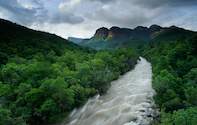
Launching K2C
Encompassing key tourism sites like Kruger National Park and the Blyde River Canyon, the Kruger to Canyons Biosphere (K2C) is South Africa's largest biosphere reserve. The biosphere received UNESCO registration in October 2001, however, the idea of the biosphere was first put forward in the 1980s. Nothing further came of this until 1998, when a biosphere steering committee was formed at a stakeholder meeting.Biosphere reserves essentially aim to correct any injustices that have been committed to local communities when protected areas, such as the Kruger National Park, were erected. Sometimes, the local people are removed from their homesteads in order for the reserves to be declared, or sometimes they experience a negative impact due to the functioning of the reserve. The K2C reserve is home to various populations of people, 97% of all being unskilled and rurally-based. Ecotourism in the region is expected to create a large amount of jobs, positively affecting the local people.
What is a Biosphere?
UNESCO defines a biosphere reserve as a specific type of conservation area, which accommodates and benefits both the natural environment and the communities living in and around it. The Kruger to Canyons biosphere has several biosphere ideals, including the presence of a core conservation area (the Kruger National Park), buffer areas where conservation is a priority along with commercial activities, and finally transitional zones where there are more people and more commercial activities.The Blyde Canyon National Park is also recognised as a core conservation area in the biosphere. The biosphere goes from the Drakensberg escarpment into the lowveld, and contains three of South Africa's seven biomes - grassland, forest and savanna. Within the Kruger to Canyons boundaries there are estimated to be 905 vertebrate species and 2760 plant species. There are numerous endemic species of plants and animals as well as over 100 red data book animal species.
One of the biosphere's objectives is to engage communities in the concept of sustainable utilisation of resources, and to guide development along sustainable lines. This is in line with the UNESCO 'Man and the Biosphere' programme launched in 1968.
The biosphere has formed an international partnership with Germany's Rhön Biosphere Reserve, with whom they share advice and trading information. Twelve representatives form K2C visited Rhön in 2007 to initiate the partnership.
Success of K2C
In 2010, collaboration between K2C and UNESCO in Germany conducted a study of the feasibility of a voluntary carbon off-set programme for visitors to the reserve. The study proved to be positive, resulting in Phase 1 of the project initiated in May 2011.Other projects that have been undertaken within the biosphere include the development of a corridor along the major rivers, efforts to deal with climate change and carbon miles, renewable energy , encouraging entrepreneurship in students and local communities, job creation, and educating communities on their rights and how to protect them.

